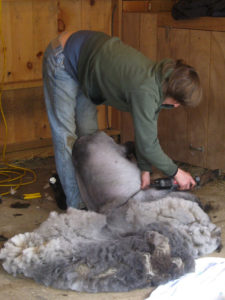
Shearing Day is an exciting and busy event on the farm. We get to harvest beautiful fiber, and it is an ideal time to check each animal closely and administer health treatments such as vaccines and hoof trimming. This is an also opportunity to take photos for the breed registry and for our own records. Here are some tips to make the day easier and more efficient. The first few times you shear, we strongly recommend that you hire a professional shearer. While doing so will cost money, it will save you time and stress.
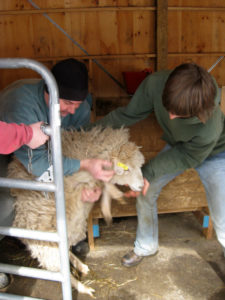
Plus, a professional shearer will deliver a well-shorn fleece with minimal second clip. Most shearers will also trim hooves for a nominal additional fee. And whether they use hand shears or electric blades, the shearer is experienced with their tool so that the can work quickly without causing injury to the sheep. Finding a shearer can be difficult depending on your location. Contact other shepherds in your area and ask who shears their sheep, and how long they have been working with the person. When you have identified a shearer, contact them ahead of time (at least two months in advance of your preferred date), and let them know how many sheep you have.
If possible, coordinate with other shepherds in your area so that the shearer can do several farm visits in one day (especially if each location has just a few sheep). Before shearing day there are a few additional details to address:
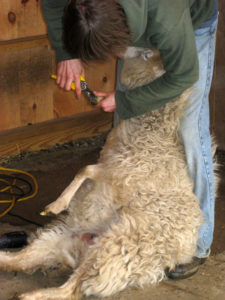
- Order any supplies you may need, such as fleece bags, vaccines, and syringes.
- Lock the sheep in their holding pen inside the shelter or barn so they stay dry. Depending on the forecast, this may mean putting the sheep inside the day before shearing to make sure they have time to dry off if the weather has been wet.
- Select a comfortable space for the shearer to work, and be sure to clean it thoroughly. Make sure it is close to the holding pen, secure, well lit, dry, and has easy access to electricity if your shearer uses electric shears.
- Have help available – at least one person to catch sheep and bring each one to the shearer, one person to gather the fleeces, and one floater to open and close gates, take photos, and sweep up between each animal.
Shearing Notes and Etiquette:
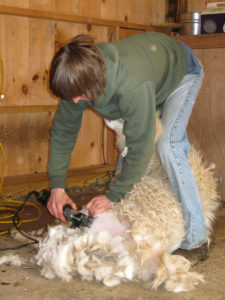
Offer food and drink to your helpers and the shearer. Organize your flock and ask the shearer if they have a preference of the order for rams and ewes. If you need to take photos, let your shearer know this so that you can coordinate your movements for an easy work flow. Work with the shearer at their pace. Don’t hover, but do be ready to take the sheep and the fleece as soon as the shearing is complete. (It only takes 2-3 minutes to shear a sheep with electric blades.) Also be ready to help out if a sheep is thrashing or if they slip away before shearing is complete.
The shearer will first discard the matted, dirty belly wool. This should be bagged separately from the prime wool. Wait until the shearer has completed the entire clip before stepping in to gather the fleece (pulling on the fleece while it is still attached can cause the sheep’s skin to stretch and risks cuts to both the sheep and the shearer). The shearer can hold the sheep in an immobilized position after the clip for easy vaccinations. Have the fleece bag ready, and know which sheep you will catch next.
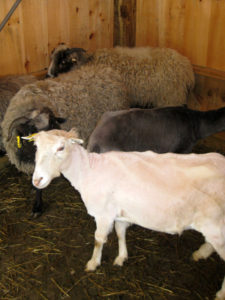
To make the sheep more comfortable, we return each one to the holding pen after it is shorn. This works particularly well with a small flock. For larger numbers of sheep, it may be more practical to turn the sheep out as they are shorn, though keep in mind that the last sheep left in the holding pen may be quite agitated while it is left alone.
Finally, thank your shearer and tip them, especially if they have driven some distance to come to your farm, or if they have come over for just a few animals.
